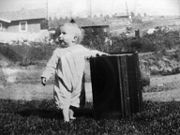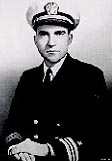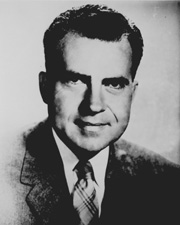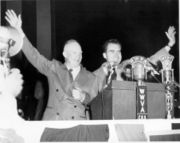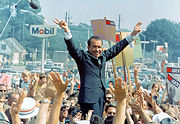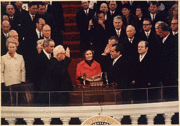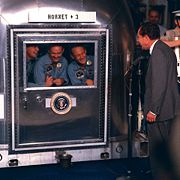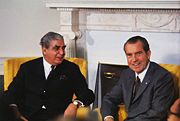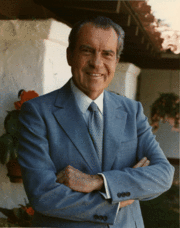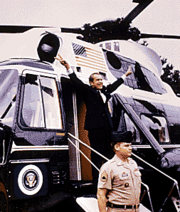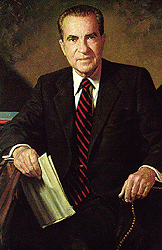Richard Nixon
2008/9 Schools Wikipedia Selection. Related subjects: USA Presidents
|
Richard Milhous Nixon
|
|
 |
|
|
|
|
|---|---|
| In office January 20, 1969 – August 9, 1974 |
|
| Vice President | Spiro T. Agnew (1969–1973) vacant (Oct.–Dec. 1973) Gerald Ford (1973–1974) |
| Preceded by | Lyndon B. Johnson |
| Succeeded by | Gerald Ford |
|
36th Vice President of the United States
|
|
| In office January 20, 1953 – January 20, 1961 |
|
| President | Dwight D. Eisenhower |
| Preceded by | Alben W. Barkley |
| Succeeded by | Lyndon B. Johnson |
|
United States Senator
from California |
|
| In office December 1, 1950 – January 1, 1953 |
|
| Preceded by | Sheridan Downey |
| Succeeded by | Thomas Kuchel |
|
Member of the United States House of Representatives from California's 12th congressional district
|
|
| In office January 2, 1947 – December 1, 1950 |
|
| Preceded by | Jerry Voorhis |
| Succeeded by | Patrick J. Hillings |
|
|
|
| Born | January 9, 1913 Yorba Linda, California |
| Died | April 22, 1994 (aged 81) New York City |
| Political party | Republican |
| Spouse | Thelma Catherine "Pat" Ryan |
| Alma mater | Whittier College Duke University School of Law |
| Occupation | Lawyer |
| Religion | Quaker |
| Signature | |
Richard Milhous Nixon ( January 9, 1913– April 22, 1994) was the thirty-seventh President of the United States (1969–1974) and the only American president to resign from that office.
Nixon was born in Yorba Linda, California and developed an interest in music. In the mid-1930s, he passed the bar exam and practiced law with a family friend. Amidst the outbreak of war in the early 1940s, he joined the United States Navy and served as a lieutenant commander in the Pacific during World War II. He was elected to Congress following his military service, specifically the House of Representatives, first representing California's 12th Congressional district, and later the entire state as Senator. He was chosen by party nominee Dwight D. Eisenhower to be Vice President in 1952, a position he began serving in the following year, until 1961. After an unsuccessful presidential run in 1960 and an unsuccessful run for Governor of California in 1962, Nixon was elected to the presidency in 1968, and reelected four years later.
Under President Nixon, the United States followed a foreign policy marked by détente with the Soviet Union and by the opening of diplomatic relations with the People's Republic of China. Nixon successfully negotiated a ceasefire with North Vietnam, effectively ending the longest war in American history. Domestically, his administration faced resistance to the Vietnam War. In the face of likely impeachment by the United States House of Representatives and conviction by the Senate for the Watergate scandal, Nixon resigned on August 9, 1974. His successor, Gerald Ford, issued a controversial pardon for any federal crimes Nixon may have committed while in office. Nixon is the only person to be elected twice to the presidency and twice to the vice presidency.
Nixon suffered a stroke on April 18, 1994 and died four days later at the age of 81.
Early life
Richard Nixon was born on February 9, 1913 to Francis A. Nixon and Hannah Milhous Nixon in a house his father built in in Yorba Linda, California. His mother was a Quaker, and his upbringing is said to have been marked by conservative Quaker observances of the time, such as refraining from drinking, dancing, and swearing. His father converted from Methodist to Quaker after his marriage. Nixon had four brothers: Harold (1909–1933), Donald (1914–1987), Arthur (1918–1925), and Ed (born 1930).
Nixon's early life was marked by financial hardships. His family's ranch failed in 1922, and they moved to Whittier, California, the home of his mother's relatives, where his father opened a grocery store.
Nixon attended Fullerton High School in Fullerton, and later graduated second in his class from Whittier High School in 1930. Insufficient financial means for attendance forced Nixon to decline a scholarship to Harvard University and to Yale University; he instead enrolled at Whittier College, a local Quaker school, where he co-founded a fraternity known as The Orthogonian Society. Nixon was a formidable debater, a stand out in collegiate drama productions, was elected student-body president, and played football. While at Whittier, he lived at home and assisted with his family's store; he also taught Sunday school at East Whittier Friends Church, where he remained a member all his life. In 1934, he graduated second in his class from Whittier, and went on to Duke University School of Law, where he received a full scholarship and graduated third in his class in June 1937.
Law practice, marriage and military service
In 1937, Nixon returned to California and was admitted to the state bar. He began working in the law offices of Wingert and Bewley.
When Nixon was cast in a community play at a local theatre in January 1938, he met high school teacher Thelma "Pat" Ryan. Smitten, Nixon pursued Ryan and they were married on June 21, 1940.
Richard and Pat moved to Washington, D.C. in January 1942 where Nixon took a job at the Office of Price Administration. He soon left that post, however, and enlisted in the United States Navy in August 1942. He received training at Naval Air Station Quonset Point, Rhode Island and was assigned to Ottumwa, Iowa, before being relocated and serving in the supply corps on several islands in the South Pacific, commanding cargo handling units in the SCAT. During World War II, he attained the rank of lieutenant commander.
Upon his return from the South Pacific n 1946, the Nixons had two daughters: Tricia, born that same year, and Julie, born in 1948.
Congressional career
House of Representatives
World War II over, prominent Whittier Republicans approached Nixon about running for Congress in 1946. Nixon accepted, and defeated Democratic incumbent Jerry Voorhis in the November election to represent southern California's 12th Congressional district in the United States House of Representatives.
In Congress, Nixon supported the Taft-Hartley Act of 1948, and served on the Education and Labor Committee. He was part of the Herter Committee as well, which staged a trip to Europe to prepare a prliminary report on the newly enacted Marshall Plan.
Nixon first gained national attention in 1948 when his investigation on the House Un-American Activities Committee (HUAC) broke the impasse of the Alger Hiss spy case. Nixon believed Whittaker Chambers's allegations that Hiss, a high State Department official, was a Soviet spy. Nixon discovered Chambers saved microfilm reproductions of incriminating documents by hiding the film in a pumpkin (these became known as the "Pumpkin Papers"). These documents were alleged both to be accessible only by Hiss, and to have been typed on Hiss's personal typewriter. Hiss was convicted of perjury in 1950 for statements he made to the HUAC. The discovery that Hiss, who had been an adviser to President Franklin D. Roosevelt, could have been a Soviet spy thrust Nixon into the public eye and made him a hero to many of Roosevelt's enemies, and an enemy to many of Roosevelt's supporters. In reality, his support for internationalism put him closer to the centre of the Republican party. This case turned the young Congressman into a national, and controversial, figure. He was easily reelected in 1948.
Senate
In the 1950 mid-term elections, Nixon challenged and defeated Democratic Representative Helen Gahagan Douglas to win a seat in the United States Senate. The campaign was very contentious, however; Nixon felt the former actress was a sympathizer to left-wing causes and said she was "pink right down to her underwear." Douglas responded by bestowed upon Nixon the nickname " Tricky Dick".
As a senator, Nixon took a prominent position in opposing global communism. He traveled frequently speaking out against what he labeled as the threat. He criticized President Harry S. Truman's handling of the Korean War as well.
Vice Presidency
Due to his prominent anti-communist rhetoric, the thirty nine year old Nixon was selected by Republican party nominee General Dwight D. Eisenhower to be Vice President at the Republican National Convention in July 1952. In September, the New York Post produced an article claiming that campaign donors were buying influence with Nixon by providing him with a secret cash fund for his personal expenses. Nixon responded by saying that the fund was not secret and produced an independent audit showing that the funds were used only for political purposes. Still, Democrats and many leading Republicans pressured Eisenhower to remove Nixon from the ticket.
Nixon appeared on television on September 23, 1952 to defend himself in a famous speech. He provided an independent third-party review of the fund's accounting along with a personal summary of his finances, and he noted the Democratic Presidential candidate, Adlai Stevenson, had a similar fund. The speech became better known for its rhetoric, such as when he stated his wife Pat did not wear mink, but rather "a respectable Republican cloth coat," and although he had been given an American Cocker Spaniel named "Checkers" in addition to his other campaign contributions, he was not going to give it back because his daughters loved him. As a result, this speech became known as the " Checkers speech." His speech resulted in much support from the Republican party base, thus keeping him on the ticket. Eisenhower and Nixon defeated their opponents, Stevenson and Alabama Senator John Sparkman, by seven million votes.
As Vice President, Nixon expanded the office, making it an important and visible post. Although he had little formal power, he had the attention of the media and the Republican Party. Using these, Nixon and Pat undertook many foreign trips of goodwill with the intent of garnering support for American policies during the Cold War. On one such trip to Caracas, Venezuela, anti-American protestors disrupted and assaulted Nixon's motorcade, injuring Venezuela's foreign minister. Nixon was lauded and attracted international media attention for his calm and coolness during the events.
In July 1959, President Eisenhower sent Nixon to the Soviet Union for Moscow's opening of the American National Exhibition. On July 24, 1959, while touring the exhibits with Soviet leader Nikita Khrushchev, they stopped at a model of an American kitchen and engaged in the impromptu " Kitchen Debate" about the merits of capitalism versus communism.
Nixon was the first Vice President to step in temporarily, and unofficially, to run the government. He did so three times when Eisenhower was ill: on the occasions of Eisenhower's heart attack on September 24, 1955; his ileitis in June 1956; and his stroke on November 25, 1957. Nixon would conduct National Security meetings in the president's absence.
1960 presidential election
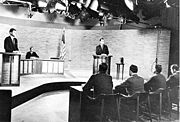
In 1960, Nixon launched his campaign for President of the United States. He faced little competition in the Republican primaries, and chose former Massachusetts Senator Henry Cabot Lodge, Jr. as his running mate. His Democratic challenger was John F. Kennedy, and the race remained close for the duration. Nixon campaigned on his experience, but Kennedy called for new blood and claimed the Eisenhower-Nixon administration allowed the Soviet Union to overtake the U.S. in offensive missiles (the " missile gap"). Kennedy made much of the stagnant American economy of 1960, telling voters it was time to "get the country moving again."
A new medium was brought to the campaign: televised presidential debates. In the first of four televised debates, Nixon was recovering from illness and, wearing little makeup, looked wan and uncomfortable, in contrast to the composed Kennedy. Nixon's performance in the debate was perceived to be mediocre in the visual medium of television, though many people listening on the radio thought Nixon won.
That November, Nixon lost the 1960 election narrowly. The final count recorded that he lost by 120,000 votes, or 0.2 percent. It is often argued by American historians that Nixon lost due to the invention of the televised debate. There were charges of vote fraud in Texas and Illinois, and Nixon supporters unsuccessfully challenged in both states as well as nine others. The Kennedy campaign successfully challenged Nixon's victory in Hawaii; after all the court battles and recounts were done, Kennedy had a greater number of electoral votes than he held after Election Day.
Wilderness years
Following his loss to Kennedy, Nixon and his family returned to California, where he practiced law and wrote a bestselling book, Six Crises. It recorded his political involvement as a congressman, senator and vice president and used six different crises Nixon had experienced throughout his political career to illustrate his political memoirs. The work won praise from many policy experts and critics. Ironically, as Margaret MacMillan would discuss in her book Nixon in China (2006), Six Crises found a favorable critic in Mao Zedong, who referred to the book when in preparation for Nixon's visit in 1972.
In 1962, local and national Republican leaders encouraged Nixon to challenge the incumbent Pat Brown for Governor of California. Despite initial reluctance, Nixon entered the race. The campaign was clouded by public suspicion that Nixon viewed the governorship as a political "stepping-stone" to a higher office, some opposition from the far-right of the party, and his own lack of interest in being California's governor. He lost to Brown by nearly 300,000 votes. This loss was widely believed to be the end of his career; in an impromptu concession speech the morning after the election, Nixon famously blamed the media for favoring his opponent, saying, "You won't have Nixon to kick around anymore because, gentlemen, this is my last press conference."
The Nixon family moved then to New York City, where Nixon became a senior partner in the leading law firm Nixon, Mudge, Rose, Guthrie & Alexander. Though largely out of the public eye, Nixon was still supported by much of the Republican base who favored his knowledge of politics and international affairs. This reputation was enhanced when Nixon wrote an article in Foreign Affairs entitled "Asia After Vietnam", and through his work campaigning for Republican candidates in the 1966 Congressional elections.
1968 presidential election
Nixon decided again to seek the Republican nomination for President of the United States in the 1968 presidential election. He portrayed himself as a figure of stability during a period of national unrest and upheaval; Nixon won the nomination. Nixon appealed to what he called the " Silent Majority" of socially conservative Americans who disliked the hippie counterculture and the anti-war demonstrators. Nixon's running mate, Maryland Governor Spiro Agnew, became an increasingly vocal critic of these groups, solidifying Nixon's position with the right.
Nixon's campaign was assisted by turmoil within the Democratic party: President Lyndon B. Johnson, consumed with the Vietnam War, announced that he would not seek reelection, Senator Robert F. Kennedy was killed in Los Angeles, and the campaign of his opponent, Democratic nominee Hubert Humphrey, experienced some rough periods following mass protests at the 1968 Democratic National Convention. At the same time, Nixon appeared to represent a calmer society. Nixon promised peace with honour, and campaigned on the notion that "new leadership will end the war and win the peace in the Pacific." He did not give specific plans on how to end the Vietnam War, causing Humphrey to allege that he must have some " secret plan."
In a three-way race between Nixon, Humphrey, and independent candidate George Wallace, Nixon defeated Humphrey by nearly 500,000 popular votes to become the 37th President of the United States.
Presidency (1969–1974)
First term
Vietnam War
Once in office, Nixon and his aides faced the problem of how to end the Vietnam War. In July 1969, he visited South Vietnam, and met with President Nguyen Van Thieu and with U.S. military commanders. Amidst protests at home, the president implemented the Nixon Doctrine, a strategy of replacing American troops with the Vietnamese troops, also called " Vietnamization." Under President Nixon, American involvement in the war steadily declined from a troop strength of 543,000 to zero 1973. Although the South Vietnamese were well supplied with modern arms, their fighting capability was limited by inadequate funding, primarily because of large funding cutbacks by the U.S. Congress. Nixon was widely praised in the United States for having delivered 'peace with honour', and ending American involvement in the war in Vietnam.
Nixon approved bombing campaigns in Cambodia in March 1969 (code-named Operation Menu) to destroy what was believed to be the headquarters of the National Front for the Liberation of Vietnam, and later escalated the conflict with secretly bombing Laos. Another goal of the bombings was to interdict the Ho Chi Minh trail that passed through Laos and Cambodia. In approving the bombings, Nixon realized he would be extending an unpopular war as well as breaching Cambodia's stated neutrality. In a televised speech on April 30, 1970, Nixon announced the incursion of U.S. troops into Cambodia to disrupt so-called North Vietnamese sanctuaries. The invasion of Cambodia, the subsequent killing, on May 4, of four students during a protest at Kent State University in Ohio and Nixon's perceived callous reaction to the violence, provoked a national student strike that involved more than four million students and 450 universities, colleges and high schools.
School integration
The Nixon years witnessed the first large-scale integration of public schools in the South, after the region had stalled in compliance with the 1954 Supreme Court's Brown ruling. Strategically, Nixon sought a middle way between the segregationist George C. Wallace and liberal Democrats, whose support of integration was alienating some Southern white Democrats. His plan has since been known as the Southern strategy. Nixon concentrated on the principle that the law must be colour-blind. "I am convinced that while legal segregation is totally wrong, forced integration of housing or education is just as wrong."
Nixon enforced the law after the Supreme Court, in Alexander v. Holmes County (1969), prohibited further delays. Nixon's Cabinet committee on school desegregation, under the leadership of Labor Secretary George P. Shultz, quietly set up local biracial committees to assure smooth compliance without violence or political grandstanding. By fall of 1970, two million southern black children enrolled in newly created unitary fully integrated school districts. "In this sense, Nixon was the greatest school desegregator in American history," historian Dean Kotlowski concluded.
U.S. space program
On July 20, 1969, Nixon addressed Neil Armstrong and Buzz Aldrin live via radio during their historic Apollo 11 moonwalk. Nixon also made humanity's longest distance phone call to Neil Armstrong on the moon. (All U.S. Project Apollo moon landings, and the attempted moon landing of Apollo 13, took place during Nixon's first term.) On January 5, 1972, Nixon approved the development of NASA's Space Shuttle program, a decision that profoundly influenced American efforts to explore and develop space for several decades thereafter.
Under the Nixon Administration, NASA's budget declined. NASA Administrator Thomas O. Paine was drawing up ambitious plans for the establishment of a permanent base on the Moon by the end of the 1970s and the launch of a manned expedition to Mars as early as 1981. Nixon, however, rejected these ideas.
Indo-Pakistani War
Nixon strongly supported General Yahya Khan of Pakistan during the Indo-Pakistani War of 1971 despite widespread human rights violations against the Bengalis, particularly Hindus, by the Pakistan Army. Though Nixon claimed that his objective was to prevent a war, and safeguard Pakistan's interests (including the issue of refugees), in reality the U.S. President was fearful of an Indian invasion of West Pakistan that would lead to Indian domination of the sub-continent and strengthen the position of the Soviet Union, which had recently signed a Treaty of Friendship with India. He also sought to demonstrate his reliability as a partner to the People's Republic of China, with whom he had been negotiating a rapprochement, and where he planned to visit just a few months later. President Nixon and his national security adviser Henry Kissinger downplayed reports of Pakistani genocide in East Pakistan (now Bangladesh) and risked a confrontation with Moscow to look tough. Many, including Kissinger, have mentioned that the foreign policy "tilt" towards Pakistan had more to do with Nixon's personal like for the dictator and the support to Pakistan was influenced by sentimental considerations and a long standing anti-Indian bias. The Nixon administration was also responsible for illegally providing military supplies to the Pakistani military despite Congressional objections, and against American public opinion, which was concerned with the atrocities against East Pakistanis. His decision to help Pakistan in a war at any cost prompted him to send the nuclear-equipped USS Enterprise to the Indian Ocean to try to threaten the Indian military. Though it did little to turn the tide of war, it has been viewed as the trigger for India's subsequent nuclear program. During the crisis Nixon was vocal in abusing the Prime Minister of India Indira Gandhi as an "old witch" in private conversations with Henry Kissinger, who is also recorded as making derogatory comments against Indians. Ultimately Nixon's foreign policy initiatives in this matter largely failed as his attempt at a show of strength to impress China was at the cost of dismembering their mutual ally, Pakistan, who felt that once again United States had fallen short as an ally in failing to prevent Bangladeshi independence.
China
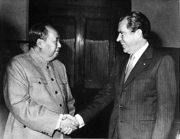
Relations between the Western powers and Eastern Bloc changed dramatically in the early 1970s. In 1960, the People's Republic of China publicly split from its main ally, the Soviet Union, in the Sino-Soviet Split. As tension along the border between the two communist nations reached its peak in 1969 and 1970, Nixon decided to use their conflict to shift the balance of power towards the West in the Cold War. The Nixon administration improved relations with China in order to gain a strategic advantage over the Soviet Union. In 1971, a move was made to improve relations when China invited an American table tennis team to China; hence the term " Ping Pong Diplomacy". Nixon sent Secretary of State Henry Kissinger on a secret mission to China in July 1971, after which a stunned world was told that Nixon intended to visit Communist China the following year. In February 1972, President and Mrs. Nixon traveled to China, where the president was to engage in direct talks with Mao Zedong. This visit ushered in a new era of Chinese-American relations. During this visit he privately stated that he believed “There is one China, and Taiwan is a part of China.” Fearing the possibility of a Sino-American alliance, the Soviet Union yielded to American pressure for détente.
Soviet Union
Nixon used the improving international environment to address the topic of nuclear peace. Following his successful visit to China, Nixon embarked on a trip to the Soviet Union, where he met with Soviet Leader Leonid Brezhnev. He engaged in intense negotiations with his Soviet counterpart, and out of this "summit meeting" came agreements for increased trade and two landmark arms control treaties: SALT I, the first comprehensive limitation pact signed by the two superpowers, and the Anti-Ballistic Missile Treaty, which banned the development of systems designed to intercept incoming missiles. Nixon and Brezhnev proclaimed a new era of "peaceful coexistence," in which détente (cooperation) would replace the hostility of the Cold War.
To win American friendship, both China and the Soviet Union cut back on their diplomatic support for North Vietnam and advised Hanoi to come to terms. Nixon later explained his strategy:
| “ | I had long believed that an indispensable element of any successful peace initiative in Vietnam was to enlist, if possible, the help of the Soviets and the Chinese. Though rapprochement with China and détente with the Soviet Union were ends in themselves, I also considered them possible means to hasten the end of the war. At worst, Hanoi was bound to feel less confident if Washington was dealing with Moscow and Beijing. At best, if the two major Communist powers decided that they had bigger fish to fry, Hanoi would be pressured into negotiating a settlement we could accept. | ” |
|
—Richard Nixon |
||
1972 Landslide re-election
In 1972, Nixon was re-elected in one of the biggest landslide election victories in US political history, defeating Senator George McGovern and garnering over 60% of the popular vote. He carried 49 of the 50 states, losing only in Massachusetts and the District of Columbia.
Second term
Domestic policies
Although often viewed as a conservative by his contemporaries, Nixon's domestic policies often appear centrist, or even liberal, to later observers. As President, Nixon imposed wage and price controls, indexed Social Security for inflation, and created Supplemental Security Income (SSI). The number of pages added to the Federal Register each year doubled under Nixon. He eradicated the last remnants of the gold standard, created the Environmental Protection Agency (EPA) and Occupational Safety and Health Administration (OSHA), promoted the Legacy of parks program and implemented the Philadelphia Plan, the first significant federal affirmative action program, and dramatically increased spending on federal employees's salaries. In the wake of racial tensions that had sometimes erupted into urban violence before he assumed the Presidency, Nixon's policy on race relations and civil rights was perceived to be influenced by a doctrine commonly referred to as " benign neglect." As a party leader, Nixon helped build the Republican Party (GOP), but he ran his 1972 campaign separately from the party, which perhaps helped the GOP escape some of the damage from Watergate. The Nixon White House was the first to organize a daily press event and daily message for the media, a practice that all subsequent staffs have performed.
Nixon is credited with creating the modern day Imperial Presidency, in which the presidency retains a high level of control over government policy and decisions. In the early 1970s, Nixon impounded billions of dollars in federal spending and expanded the power of the Office of Management and Budget. These encroachments on the power of Congress led to the passage of the Congressional Budget and Impoundment Control Act of 1974.
Government system
| The Nixon Cabinet | ||
|---|---|---|
| Office | Name | Term |
| President | Richard Nixon | 1969–1974 |
| Vice President | Spiro Agnew | 1969–1973 |
| Gerald Ford | 1973–1974 | |
| Secretary of State | William P. Rogers | 1969–1973 |
| Henry Kissinger | 1973–1974 | |
| Secretary of Treasury | David M. Kennedy | 1969–1971 |
| John Connally | 1971–1972 | |
| George Shultz | 1972–1974 | |
| William Simon | 1974– | |
| Secretary of Defense | Melvin R. Laird | 1969–1973 |
| Elliot Richardson | 1973– | |
| James Schlesinger | 1973–1974 | |
| Attorney General | John N. Mitchell | 1969–1972 |
| Richard Kleindienst | 1972–1973 | |
| Elliot Richardson | 1973–1974 | |
| William B. Saxbe | 1974– | |
| Postmaster General | Winton M. Blount | 1969–1971 |
| Secretary of the Interior | Walter Joseph Hickel | 1969–1971 |
| Rogers Morton | 1971–1974 | |
| Secretary of Agriculture | Clifford M. Hardin | 1969–1971 |
| Earl Butz | 1971–1974 | |
| Secretary of Commerce | Maurice Stans | 1969–1972 |
| Peter Peterson | 1972–1973 | |
| Frederick B. Dent | 1973–1974 | |
| Secretary of Labor | George Shultz | 1969–1970 |
| James D. Hodgson | 1970–1973 | |
| Peter J. Brennan | 1973–1974 | |
| Secretary of Health, Education, and Welfare |
Robert Finch | 1969–1970 |
| Elliot Richardson | 1970–1973 | |
| Caspar Weinberger | 1973–1974 | |
| Secretary of Housing and Urban Development |
George Romney | 1969–1973 |
| James Thomas Lynn | 1973–1974 | |
| Secretary of Transportation | John A. Volpe | 1969–1973 |
| Claude Brinegar | 1973–1974 | |
During the Nixon Administration, the United States established many government agencies, including the Environmental Protection Agency, the National Oceanic and Atmospheric Administration, the National Railroad Passenger Corporation, the Drug Enforcement Administration, the Supplemental Security Income program, and the Office of Minority Business Enterprise; the Post Office Department was abolished as a cabinet department and reorganized as a government-owned corporation: the U.S. Postal Service. Nixon proposed in 1971 to create four new government departments superseding the current structure: departments organized for the goal of efficient and effective public service as opposed the thematic bases of Commerce, Labor, Transportation, Agriculture, et al. Departments including the State, Treasury, Defense, and Justice would remain under this proposal.
On January 2, 1974, Nixon signed a bill that lowered the maximum U.S. speed limit to 55 miles per hour (90 km/h) in order to conserve gasoline during the 1973 energy crisis. This law remained in effect until 1995, though states had been allowed to raise the limit to 65 miles per hour in rural areas since 1987. Nixon also suspended the converting of the U.S. dollar into gold, a central point of the Bretton Woods system, allowing its value to float in world markets.
In his 1974 State of the Union address, Nixon called for comprehensive health insurance. On February 6, 1974, he introduced the Comprehensive Health Insurance Act. Nixon's plan would have mandated employers to purchase health insurance for their employees, and in addition provided a federal health plan, such as Medicaid, that any American could join by paying on a sliding scale based on income.
On October 10, 1973, Vice President Spiro Agnew resigned amidst charges of bribery, tax evasion and money laundering. Nixon chose Representative Gerald Ford (and Republican Minority Leader of the House of Representativees) to replace Agnew.
Yom Kippur War
Israel, a powerful American ally in the Middle East, was supported by the Nixon administration during the Yom Kippur War. When an Arab coalition led by Egypt and Syria—allies to the Soviets—attacked in October 1973 Israel suffered initial losses and pressed European powers for help, but (with the notable exception of the Netherlands) the Europeans responded with inaction. Not so with Nixon, who, cutting through inter-departmental squabbles and bureaucracy, initiated an air lift of American arms. By the time the U.S. and the Soviet Union negotiated a truce, Israel had penetrated deep into enemy territory. A long term effect was the movement of Egypt away from the Soviets toward the U.S. But the victory for its ally and the support provided to them by the U.S. came at the cost of the 1973 oil crisis.
Watergate
The term Watergate has come to encompass an array of illegal and secret activities undertaken by Nixon or his aides during his administration. These activities did not come to light until several men were caught breaking into Democratic Party headquarters at the Watergate Hotel in Washington, D.C. on June 17, 1972. The men were subsequently linked to the White House. This became one of a series of major scandals involving the Committee to Re-Elect the President, including the White House enemies list and assorted " dirty tricks." The ensuing Watergate scandal exposed the corruption, illegality and deceit displayed by some of those within the Nixon administration.
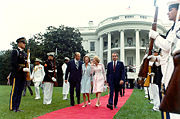
Nixon himself downplayed the scandal as mere politics, but when his aides began resigning, Nixon's alleged role in ordering an illegal cover-up came to light in the press, courts, and congressional investigations. He had accepted illicit campaign contributions, and had harassed opponents with executive agencies, wiretaps, and break-ins. Unlike the tape recordings by earlier Presidents, his secret recordings of White House conversations were revealed, subpoenaed, and showed details of his alledged complicity in the cover-up. Nixon was named by the grand jury investigating Watergate as "an unindicted co-conspirator" in the Watergate scandal.
One piece of evidence, an audio tape of conversations held in the White House between the President and various aides on June 20, 1972, features an unexplained 18½ minute gap. The first deleted section, of about five minutes, has been attributed to human error on the part of Rose Mary Woods, the President's personal secretary, who admitted accidentally wiping the section while transcribing the tape. No definitive explanation has been offered for the deletion of the remaining conversations, but contextual evidence suggests that Nixon and then-Chief of Staff Bob Haldeman discussed the Watergate problem in the conversation obliterated. The gap, while not conclusive proof of wrong-doing on the part of the President, cast doubt on Nixon's claim that he was unaware of the cover-up at this stage. Although not discovered until several years after he had left office, transcripts of an earlier June 20, 1972 conversation between Nixon and White House Special Counsel Charles Colson clearly show Nixon's early involvement in obstructing justice in the Watergate investigation.
Nixon lost support from some in his own party as well as much popular support after what became known as the Saturday Night Massacre of October 20, 1973. As the Watergate story continued to dominate headlines, Nixon tried to reassure a suspicious public by continuing to deflect himself from any wrongdoing. On November 17, 1973, during a televised question and answer session with the press, Nixon said,
| “ | People have got to know whether or not their President is a crook. Well, I'm not a crook. I've earned everything I've got. | ” |
The House Judiciary Committee controlled by Democrats opened formal and public impeachment hearings against Nixon on May 9, 1974. Despite his efforts, one of the secret recordings, known as the "smoking gun" tape, was released on August 5, 1974, and revealed that Nixon authorized hush money to Watergate burglar E. Howard Hunt. In light of his loss of political support and the near certainty of both his impeachment and conviction, Nixon resigned the office of the presidency on August 9, 1974, after addressing the nation on television the previous evening. listen He never admitted to criminal wrongdoing, although he later conceded errors of judgment. During the Watergate scandal, Nixon's approval rating had fallen to 23%.
Supreme Court appointments
Nixon appointed the following Justices to the Supreme Court of the United States:
- Warren E. Burger ( Chief Justice) — 1969
- Harry Andrew Blackmun — 1970
- Lewis Franklin Powell, Jr. — 1972
- William Rehnquist — 1972
Later life
Following his resignation, Nixon and Pat returned to their home, La Casa Pacifica, in San Clemente, California. The Nixons later moved to New York City in 1980, and Bergen County, New Jersey in 1981.
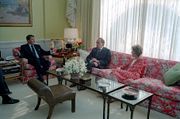
As a result of Watergate, Nixon was disbarred by the State of New York. He had attempted to resign his license, but the State refused to let him do so unless he admitted wrongdoing in Watergate. He later resigned his other law licenses. On September 8, 1974, however, he was pardoned from any wrongdoing by his successor, President Gerald Ford. This ended any possibility of an indictment. The pardon was controversial and Nixon's critics claimed that it was quid pro quo for his resignation.
In his later career, former President Nixon traveled extensively, both domestically and internationally. He undertook trips to Europe, the Middle East, Russia, Africa, and Asia. In 1981, he joined former Presidents Ford and Jimmy Carter as representatives of the United States at the funeral of Egyptian President Anwar al-Sadat. He later joined Japanese Prime Minister Yasuhiro Nakasone in Japan, Chinese leader Deng Xiaoping in China, and Communist leader Mikhail Gorbachev in the Soviet Union. On his return from the Soviet Union trip, Nixon sent President Ronald Reagan a lengthy memorandum that contained foreign policy suggestions and his personal impressions of Gorbachev.
Nixon authored ten books in his later life and maintained a routine schedule of speaking enagagements and writing. Nixon gained great respect as an elder statesman in the area of foreign affairs, being consulted by both Democratic and Republican successors to the presidency.
On July 19, 1990, the Richard Nixon Library and Birthplace in Yorba Linda, California opened as a private institution, with President Nixon and First Lady Pat Nixon in attendance. They were joined by a throng of people, including Presidents Gerald Ford, Ronald Reagan, and George H. W. Bush, and their First Ladies Betty, Nancy, and Barbara, respectively. From the time of its original dedication until July 11, 2007, the property was owned and operated by a private foundation and was not part of the National Archives' presidential libraries system. On July 11, the Richard Nixon Presidential Library and Museum was officially welcomed into the federal presidential library system.
Pat Nixon's death
First Lady Pat Nixon died June 22, 1993 of health problems, including two strokes and lung cancer. Her funeral services were held on the grounds of the Richard Nixon Library and Birthplace in Yorba Linda, California during the week until her burial on June 26. Richard Nixon was in deep sadness the entire time, but was comforted by his family as well as former presidents Gerald Ford and Ronald Reagan, and their First Ladies, Betty and Nancy, respectively.
Death and funeral
Nixon suffered a severe stroke at 5:45 p.m. EDT on Monday, April 18, 1994, while preparing to eat dinner in his Park Ridge, New Jersey home. It was determined that a blood clot resulting from his heart condition had formed in his upper heart, then broke off and traveled to his brain. He was rushed by ambulance to New York Hospital-Cornell Medical Centre in Manhattan, initially alert, but unable to speak or to move his right arm or leg. His vision was reportedly also impaired, but he was able to greet his private doctor and daughters on separate occasions with strong squeezes from his left hand and his renowned thumbs-up salute.
Doctors initially claimed Nixon's stroke was minor, but the damage to the brain caused swelling ( cerebral edema). Less than 24 hours after his arrival at the hospital, Nixon's level of consciousness began falling sharply, and on Thursday, April 21, 1994, he slipped into a deep coma. Nixon's living will stipulated that he was not to be placed on a ventilator to sustain his life. On Friday, April 22, 1994, he died at 9:08 p.m., with his daughters at his bedside; he was 81.
Nixon's funeral took place on April 27, 1994, the first for an American President since that of Lyndon B. Johnson in 1973, which was presided over by Nixon during his presidency. Speakers at the service, held at the Richard Nixon Library and Birthplace (now Richard Nixon Presidential Library and Museum), included then-President Bill Clinton, former secretary of state Henry Kissinger, Senate Minority Leader Bob Dole, California Governor Pete Wilson, and the Reverend Billy Graham. Also in attendance were former Presidents Gerald Ford, Jimmy Carter, Ronald Reagan, George H. W. Bush and their respective first ladies. Nixon was buried beside his wife, Pat, on the grounds of the Nixon Library. He was survived by his two daughters, Tricia and Julie, and four grandchildren. In keeping with his wishes, his funeral was not a state funeral, though his body did lie in respose in the Nixon Library lobby prior to the funeral services.
Legacy
Presidential scholars, both liberal and conservative, generally agree that Nixon presents a special problem when seeking to evaluate and determine his presidential ranking because his foreign policy and domestic policy successes stand in dramatic contradiction to the corrupt elements in his administration. Political scientist Walter Dean Burnham noted the "dichotomous or schizoid profiles. On some very important dimensions both Wilson and L.B. Johnson were outright failures in my view; while on others they rank very high indeed. Similarly with Nixon." Historian Alan Brinkley said: "There are presidents who could be considered both failures and great or near great (for example, Wilson, Johnson, Nixon)." James MacGregor Burns observed of Nixon, "How can one evaluate such an idiosyncratic President, so brilliant and so morally lacking?" Even George McGovern, eleven years after Nixon defeated him for the presidency, commented: "President Nixon probably had a more practical approach to the two superpowers, China and the Soviet Union, than any other president since World War II. ... I think, with the exception of his inexcusable continuation of the war in Vietnam, Nixon really will get high marks in history."
Public perception
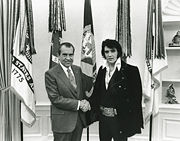
Nixon's career was frequently dogged by his personality, and the public perception of it. Editorial cartoonists such as Herblock and comedians had fun exaggerating Nixon's appearance and mannerisms, to the point where the line between the human and the caricature version of him became increasingly blurred. He was often portrayed as a sullen loner, with unshaven jowls, slumped shoulders, and a furrowed, sweaty brow. He was also characterized as the epitome of a "square" and the personification of unpleasant adult authority.
Nixon tried to shed these perceptions by staging photo-ops with young people and even cameo appearances on popular TV shows such as Laugh-In and Hee Haw (before he was President). He also frequently brandished the two-finger V sign (alternately viewed as the "Victory sign" or "peace sign") using both hands, an act that became one of his best-known trademarks. Due to his uptight image, many Americans were shocked to hear that the President had a much gruffer, aggressive side, revealed by the sheer amount of swearing and vicious comments seen on the transcripts of the president's White House tapes. This did not help the public perception and fed the comedians even more. Nixon's sense of being persecuted by his "enemies," his grandiose belief in his own moral and political excellence, and his willingness to use power ruthlessly to achieve political goals led some experts to describe him as having a narcissistic and paranoid personality.
